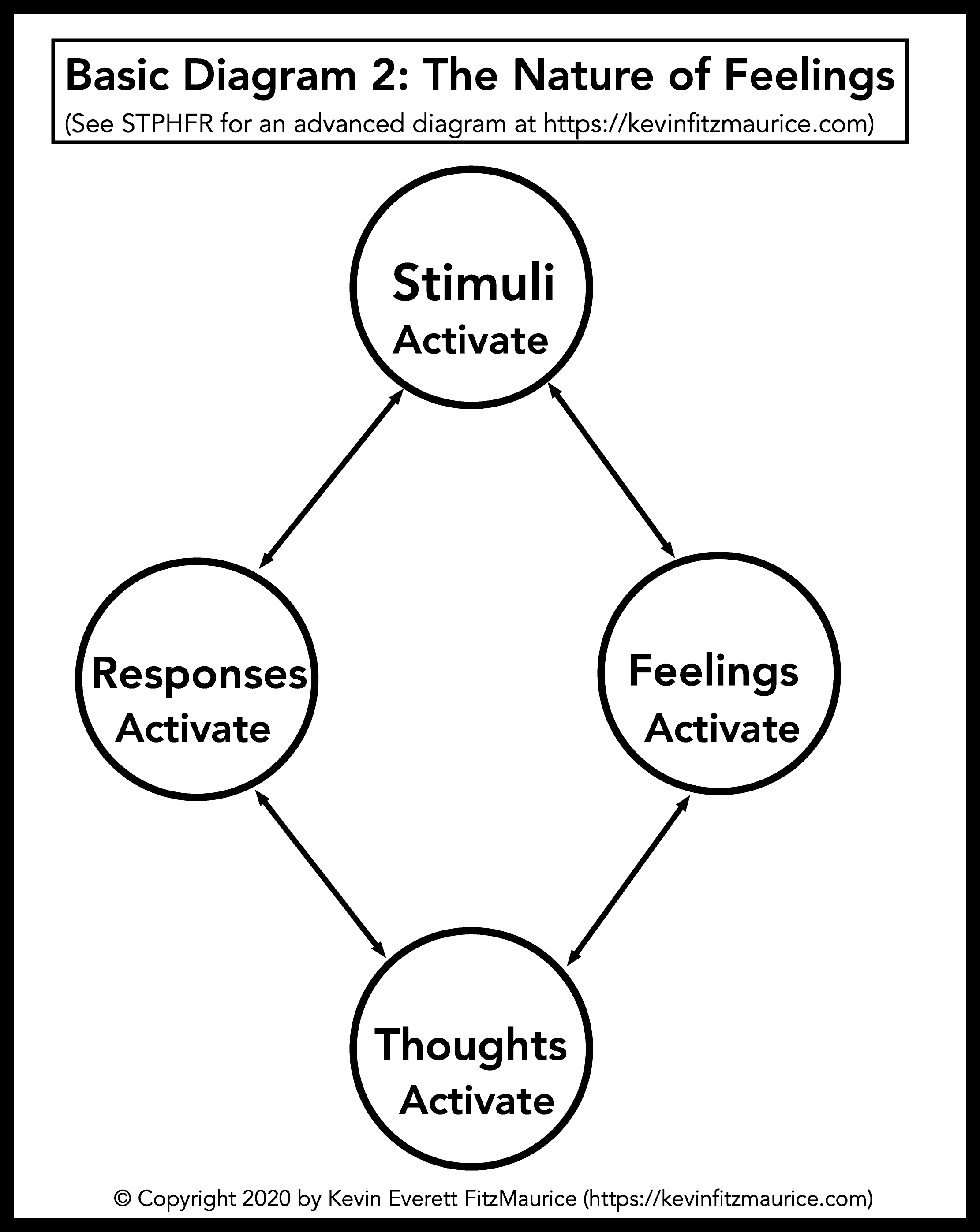FeelingsExplanationDiagramAlternate Diagram3D: Daily DoseRelated Pages6 Groups of Topics9 Skills & Topics
Diagram Feelings & Interactions
Stimuli, Feelings, Thoughts, & Responses
- Garden will teach you an easy and effective Cognitive Behavioral Therapy (CBT & REBT) system.
- Secret of Maturity, 4th Ed., will guide you to emotional responsibility for only $2.99.
Diagram Feelings: Understand the nature of feelings and the relationship between events, feelings, thoughts, and responses to events.
“You’d better strongly think, believe, and yes, feel that you can control your own emotional destiny. Not others’ thoughts and actions. No, not the fate of the world. But your thoughts, feelings, and actions.” —Albert Ellis
- Read and discover the most advanced and complete understanding of feelings.
- Diagram Feelings: This book will help you understand and apply the information.
Diagram Feelings: Explanation of the Diagram
Stimuli is the plural of stimulus.
- Stimuli can be understood as what happened.
- The stimuli are what you reacted to.
- Stimuli are often events in the world but can also be physical or mental.
Feelings
- Feelings are the sensations that you have after making contact with stimuli.
Thoughts
- Thoughts are your ideas regarding what to do about your feelings.
Responses
- Responses are the actions that you take regarding your feelings about what happened.
Impulses
- Impulses are the driving forces that prompt you to react with feelings, thoughts, and responses to events to stimuli.
- Read and discover the most advanced and complete understanding of feelings.
- Diagram Feelings: This book will help you understand and apply the information.
Diagram Feelings: Basic Diagram
- Click for a more complete understanding of feelings.
- Read and discover the most advanced and complete understanding of feelings.
- Diagram Feelings: This book will help you understand and apply the information.
Diagram Feelings: A Second Version
- Click for the book that this diagram is about.
- Read and discover the most advanced and complete understanding of feelings.
- Diagram Feelings: This book will help you understand and apply the information.
Diagram Feelings
3D: Daily Dose: 2020
#Feeling #Steps: 2020-02-20
- Stimuli (developments, events, happenings, incidents) get our attention.
- We contact these stimuli and have feelings (sensations) about them.
- We then think about these feelings and what they mean for our safety, story, and progress.
- We then choose responses to the stimuli to increase or decrease them based on what we think about these feelings.
- Impulses prompt these steps we are mostly unaware of because they are often energy-based, nonverbal, intuitive, and primordial rather than intentional.
#Emotion #Thought: 2020-03-15
- Thoughts do not cause emotions because the cause of emotions is sensations.
- Thoughts do interact with and recall emotions by naming sensations.
- Thoughts do feed and maintain emotions by reminding the emotions of sensations.
- Thoughts do embellish and exaggerate emotions by naming sensations in extreme ways.
- Thoughts do select things to have emotions about by highlighting sensations and making them important.
#Emotion #Sensation: 2020-03-16
- Emotions come from contact with sensations, not thoughts.
- Emotions are fed and maintained by sensations, not thoughts.
- Emotions are focused on and interested in sensations, not thoughts.
- Emotions are recalled and remembered by sensations, not thoughts.
- Emotions are chosen and selected by choosing and selecting sensations, not thoughts.
#Important #Sensations: 2020-03-17
- Sensations are the basis of meaning and purpose [feelings are sensations about sensations].
- Sensations are more important and taken more seriously than thoughts.
- Sensations naturally persist longer in memory than other psychological phenomena (sensing, images, naming, identifying, judging, thinking).
- Sensations have a greater effect and impact than other psychological phenomena.
- All psychological phenomena are eventually about sensations to claim intention and meaning.
- Read and discover the most advanced and complete understanding of feelings.
- Diagram Feelings: This book will help you understand and apply the information.
Diagram Feelings: Related Pages of Free Information
- 9 Superstitions about Feelings
- CBT, CT, & REBT Cognitive Psychotherapies: List Pages
- Coping Skills: Free Help
- Counseling Issues: Free Help
- Emotional Responsibility: List Pages
- Exercises & Techniques: List Pages
- Feeling & Coping Fast-Facts
- Feelings & Emotions: List Pages
- REBT (Rational Emotive Behavior Therapy): List Pages
- Self-Esteem Issues: List Pages
- STPHFR Infographic
- STIFFER: Stoic Mind
- Thinking Skills: Seven Thinking Errors of CT
- Unconditional Self-Esteem (USE): Defined
- Read and discover the best diagrams and maps of how people play games with your mind and heart.
- Read and discover how CBT, REBT, & Stoicism evolved into one system: STPHFR.
- Read and discover the most advanced and complete understanding of feelings.
- Diagram Feelings: This book will help you understand and apply the information.
Diagram Feelings: 6 Groups of Topics Menu
- 1. Pages by Topic
- 2. Fast-Facts by Topic
- 3. Quotations by Topic
- 4. Poems by Topic
- 5. Scripture by Topic
- 6. Websites by Topic
- Read and discover how CBT, REBT, & Stoicism evolved into one system: STPHFR.
- Read and discover the world’s best breathing exercise for centering and peace of mind.
- Read and discover the most advanced and complete understanding of feelings.
- Diagram Feelings: This book will help you understand and apply the information.
Diagram Feelings: 9 Skills & Topics Menu
- 1. Anger Skills & Topics
- 2. Blame Skills & Topics
- 3. Communication Skills & Topics
- 4. Coping Skills & Topics
- 5. Counseling Skills & Topics
- 6. Praying Skills & Topics
- 7. Recovery Skills & Topics
- 8. Responsibility Skills & Topics
- 9. Thinking Skills & Topics
- Read and discover how CBT, REBT, & Stoicism evolved into one system: STPHFR.
- Read and discover the world’s best breathing exercise for centering and peace of mind.
- Read and discover the most advanced and complete understanding of feelings.
- Diagram Feelings: This book will help you understand and apply the information.






